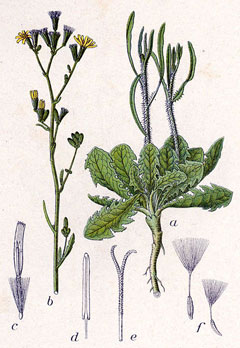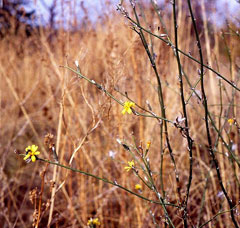 |
|
http://commons.wikimedia.org/wiki/File:Chondrilla_juncea_Sturm42.jpg |
 |
| http://commons.wikimedia.org/wiki/User:Franz_Xaver |
Translate this page:
Summary
Physical Characteristics

 Chondrilla juncea is a BIENNIAL/PERENNIAL growing to 1 m (3ft 3in).
Chondrilla juncea is a BIENNIAL/PERENNIAL growing to 1 m (3ft 3in).
See above for USDA hardiness. It is hardy to UK zone 7. It is in flower from July to September. The species is hermaphrodite (has both male and female organs) and is pollinated by Insects.
Suitable for: light (sandy) and medium (loamy) soils and prefers well-drained soil. Suitable pH: mildly acid, neutral and basic (mildly alkaline) soils. It cannot grow in the shade. It prefers dry or moist soil.
UK Hardiness Map
US Hardiness Map
Synonyms
Plant Habitats
Cultivated Beds;
Edible Uses
Edible Parts: Leaves
Edible Uses:
Leaves - raw or cooked[2, 105, 177]. A pleasant mild taste, the leaves are a favoured wild salad in France[217].
References More on Edible Uses
Medicinal Uses
Plants For A Future can not take any responsibility for any adverse effects from the use of plants. Always seek advice from a professional before using a plant medicinally.
Stomachic
The plant can be used as a stomachic[2].
References More on Medicinal Uses
The Bookshop: Edible Plant Books
Our Latest books on Perennial Plants For Food Forests and Permaculture Gardens in paperback or digital formats.

Edible Tropical Plants
Food Forest Plants for Hotter Conditions: 250+ Plants For Tropical Food Forests & Permaculture Gardens.
More

Edible Temperate Plants
Plants for Your Food Forest: 500 Plants for Temperate Food Forests & Permaculture Gardens.
More

More Books
PFAF have eight books available in paperback and digital formats. Browse the shop for more information.
Shop Now
Other Uses
In some Mediterranean regions, it has been grazed by sheep and goats, especially when other forage is scarce. However, its palatability and nutritional value decline with age, and it can become too tough or fibrous. Soil Stabilization / Erosion Control: Its deep, fibrous root system helps bind sandy or degraded soils, making it useful (in theory) for: Preventing erosion on slopes or degraded pastures. Revegetation of poor soils (though its invasiveness is a serious consideration here). Pollinator Resource: Its small yellow flowers provide nectar and pollen for bees and other insects, especially in dry seasons when few other plants are flowering. Traditional / Folk Uses: In traditional medicine (e.g. in some parts of Turkey and the Middle East), it’s been used for digestive issues or diuretic effects. However, these uses are not widely studied or standardized.
Special Uses
References More on Other Uses
Cultivation details
We have very little information on this species and do not know if it will be hardy in Britain, though judging by its native range it should succeed outdoors in many parts of this country. Judging by its native habitat it probably requires a very well drained light soil in a sunny position.
References Carbon Farming Information and Carbon Sequestration Information
Temperature Converter
Type a value in the Celsius field to convert the value to Fahrenheit:
Fahrenheit:
The PFAF Bookshop
Plants For A Future have a number of books available in paperback and digital form. Book titles include Edible Plants, Edible Perennials, Edible Trees,Edible Shrubs, Woodland Gardening, and Temperate Food Forest Plants. Our new book is Food Forest Plants For Hotter Conditions (Tropical and Sub-Tropical).
Shop Now
Plant Propagation
Seed - we have no information on this species but suggest sowing the seed in early spring in a greenhouse and only just covering the seed. When they are large enough to handle, prick the seedlings out into individual pots and grow them on in a greenhouse for at least their first winter. Plant them out into their permanent positions in late spring or early summer, after the last expected frosts.
Other Names
If available other names are mentioned here
Naked weed, Skeleton weed, gum succory, devil's grass, Ajenjera, Ajinjera, Balaguera, Baleo, Citnik, Karavuk, Su porru, Tavka.
Native Range
TEMPERATE ASIA: Afghanistan (west), Cyprus, Iran, Iraq, Israel, Jordan, Lebanon, Syria, Turkey, Russian Federation-Ciscaucasia (Ciscaucasia), Armenia, Azerbaijan, Georgia, Turkmenistan EUROPE: Austria, Switzerland, Czech Republic, Germany, Hungary, Netherlands, Poland, Slovakia, Russian Federation (European part), Belarus, Moldova, Ukraine (incl. Krym), Albania, Bulgaria, Bosnia and Herzegovina, Greece (incl. Crete), Croatia, Italy (incl. Sardinia, Sicily), North Macedonia, Montenegro, Romania, Serbia, Slovenia, Spain (incl. Baleares), France (incl. Corsica), Portugal AFRICA: Algeria, Libya (northwest), Morocco, Tunisia
Weed Potential
Right plant wrong place. We are currently updating this section.
Please note that a plant may be invasive in one area but may not in your area so it's worth checking.
This plant can be weedy or invasive. Native to Europe, Asia, and North Africa, but known throughout most temperate regions of the world as an introduced species which is considered a noxious weed. There are several biological control measures used against this plant. The skeletonweed gall midge (Cystiphora schmidti - an insect), the skeletonweed gall mite (Aceria chondrillae - an arachnid), and skeletonweed rust (Puccinia chondrillina - a fungus) all show potential for controlling infestations.
Conservation Status
IUCN Red List of Threatened Plants Status : This taxon has not yet been assessed.

Growth: S = slow M = medium F = fast. Soil: L = light (sandy) M = medium H = heavy (clay). pH: A = acid N = neutral B = basic (alkaline). Shade: F = full shade S = semi-shade N = no shade. Moisture: D = dry M = Moist We = wet Wa = water.
Now available:
Food Forest Plants for Mediterranean Conditions
350+ Perennial Plants For Mediterranean and Drier Food Forests and Permaculture Gardens.
[Paperback and eBook]
This is the third in Plants For A Future's series of plant guides for food forests tailored to
specific climate zones. Following volumes on temperate and tropical ecosystems, this book focuses
on species suited to Mediterranean conditions—regions with hot, dry summers and cool, wet winters,
often facing the added challenge of climate change.
Read More
Expert comment
Author
L.
Botanical References
50
Links / References
For a list of references used on this page please go here
Readers comment
© 2010, Plants For A Future. Plants For A Future is a charitable company limited by guarantee, registered in England and Wales. Charity No. 1057719, Company No. 3204567.